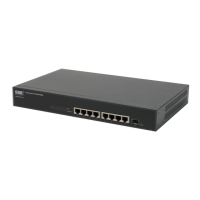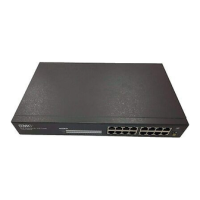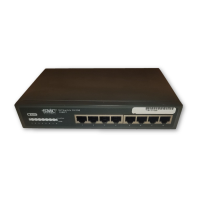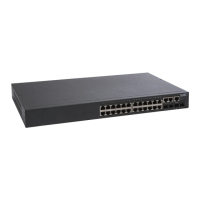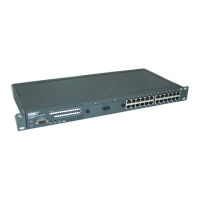Web Configuration
3-31
POE
The switch can provide DC power to a wide range of connected devices, eliminating
the need for an additional power source and cutting down on the amount of cables
attached to each device. Once configured to supply power, an automatic detection
process is initialized by the switch that is authenticated by a PoE signature from the
connected device. Detection and authentication prevent damage to non-802.3af
compliant devices.
The switch’s power management enables total switch power and individual port
power to be controlled within the switch power budget. Port power can be
automatically turned on and off for connected devices, and a per-port power priority
can be set so that the switch never exceeds its power budget. When a device is
connected to a switch port, its power requirements are detected by the switch before
power is supplied. If the power required by a device exceeds the power budget of
the port or the whole switch, power is not supplied.
Ports can be set to one of four power priority levels, critical, high, medium, or low. To
control the power supply within the switch’s budget, ports set at critical or high
priority have power enabled in preference to those ports set at low priority. For
example, when a device is connected to a port set to critical priority, the switch
supplies the required power, if necessary by dropping power to ports set for a lower
priority. If power is dropped to some low-priority ports and later the power demands
on the switch fall back within its budget, the dropped power is automatically
restored. If PoE port priority is not configured, power is automatically allocated to the
port according its port number, ie. lower numbered ports are assigned a higher
priority for power delivery.
Switch Power Status
Displays the Power over Ethernet parameters for the switch.
Field Attributes
• Port 1 Power Mode – Port 1 may be configured to supply as much as 25 watts of
power when set to High mode. In normal mode it can supply a maximum of 15.4
watts. (Default: Normal)
• Power Reservation – Displays the percentage of power budget (60W) being
drawn by attached devices.
• Port – The port number.
• PoE Enabled – The administrative status of PoE power on the port.
• Delivering Power – The current operating status of PoE power on the port.
• Current – The current power consumption on the port.
• Priority – The port’s configured power priority setting. (Range: Low, Medium,
High, Critical; Default: Low)

